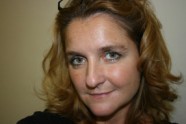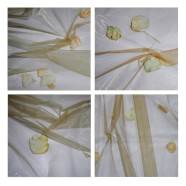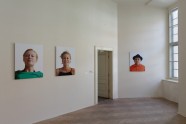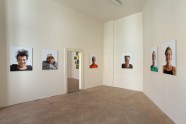
Milena Dopitová
born: 25. 10. 1963, Šternberk; lives and works in Prague (CZ)
graduate: Academy of Fine Arts, Prague
address: Schnirchova 30, 170 00 Praha 7, Česká republika
e-mail: m.dopitova@email.cz
http://www.milenadopitova.cz
”Let’s not talk about art, let’s talk about something else... about perfume” was the working title that this year connected and passed through the works of the participants of the Mikulov Art Symposium. The choice of this concept pointed towards confronting the whole, towards the atmosphere of momentary feelings, moods and needs. It opened up opportunities for approaching the qualities of general as well as concrete (personal) smell. It offered an unlimited series of features, events, situations, descriptions... being at the same time positive and sexy. The participants’ initial creed was: “We are open towards our flacon, and we trust it.”
Perfumes are distinguished by the percentage of the perfume component. When applying perfume, one should make sure the smell does not bother anyone around. On hot days, you’d better wear non-conflicting and fresh scents and you should not wear more perfume at the same time to avoid a disharmonic mix. Some producers offer lines of single-component perfumes so that you can come up with you own favourite combinations that resonate with the natural smell of the skin. Perfumes last differently and some of their ingredients decay quickly, changing the perfume significantly over several months. Daylight is the most dangerous which makes the colour of the liquid go brown. Any failure to respect these basic rules may spoil the perfume’s purpose and mission but it still has a scent.
I did a survey among my students what can be a smell. Many answers were similar. Smell is colour, shape, home, memories, happiness, passion, sex, music, good humour, laughter, cry, disease, travelling, love, hate, boredom... There were also answers like, gasoline stinks and I want to sniff it, a donut smells nice today but not in a week’s time, permanent smell is not possible, what smells mice today might smell so tomorrow, what will smell nice to me tomorrow in fact stank to me yesterday, and so on.
The way I think of smell was inspired in the film “Perfume: The Story of a Murderer” by Tom Tykwer, based on the novel by the German writer Patrick Suskind.
The book’s plot is nearly impossible to transfer to a film because of so many emotions, sensitive details and “smells”. The main character was born at the smelliest place in Europe – the Paris fish market – among bloody fish, worms, and rot. He eventually became the city’s most famous perfumer in the 18th century, and created the most sensual perfume of all times – a scent extracted from the bodies of beautiful murdered girls. The character represents the perversely deformed human desire for perfection and beauty. Besides some poetic and even affected shots, the film presents the story in naturalist way; it is about senses, it attacks the spectator, it mediates tastes and smell perceptions.
It’s difficult to find an unambiguous definition of smell. It is so individual and colourful that it cannot be bound, delimit or generalize. A question comes to mind: can we tell a real experience without smelling something?
The contemporary world is naturally inclined to quick development of new technologies; it comes up with new questions and defines new paradigms. With it comes the transformation of reality and re-evaluation of habitual relations and attitudes. On the other hand, the virtual mode of accepting the real world through ready-made programmes leads to automatic aesthetic operations which exist in unlimited quantities. The fascination by these undiscovered territories and spaces and their combinations brings with it the uncertainty whether we still are part of the world in which we can, without being programmed, feel, perceive, create and judge a work of art in its uniqueness and indispensability.
At the symposium, an open space for communication was established and its participants created works related to the original theme as well as those that shifted it to other levels and meanings. The symposium’s final exhibition was entitled “Esprit Vacuum”. Esprit – wit, ingenuity, vivacity and style... in the enclosed space – vacuum. Somewhere specific where we are allowed to peek but also something with a sovereign trace and a definite mission.
The 17th year of the “dílna” symposium hosted artists who work with various media. Besides paintings by Petr Písařík, Petr Lysáček, Michaela Vrbková and Kamila Rýparová, there were also photographs and space visual concepts by František Kowolowski, Irena Jůzová, Tereza Velíková and Milena Dopitová. The final list of authors was a combination of the curator’s choice and the winning nominations submitted by the council of experts of the town Mikulov.
The final exhibition of the participants’ works confirmed their professional attitude and their quality within their field, as well as their ability in different media.
For the third year in a row, there was also a parallel music symposium, held towards the end of the art symposium and originally established by Libor Lípa, Zdeněk Lhotský, Milan Esterka, Vítězslav Vrbka...
This year, the music symposium worked under the supervision of Petr Krkavec and prepared a programmed consisting of eight compositions, with several other bands taking part. The composition “Zimmer Frei” was a joint project of both symposiums and was very well received, not only because of its suggestive, cabaret performance of Petr Lysáček, the scratch input of Fratišek Kowolowski, the vocals of Tereza Volíková, Michaela Vrbková and Kamila Rýparová, but also thanks to its graduating musical composition.
The possibility of interconnecting various fields adds value to the wuality, significance and meaning of these activities. This year’s cooperation between the two symposiums contributed to the unique atmosphere and experience at the opening of the final exhibition.
Let me now return to the story of the film I mentioned above where the spectator anticipates a relief over the end of suffering and the punishment of the evil. But a sudden twist in the plot brings almost unbearable beauty and love. Whenever art mediates and sets off emotions, it is proof that we feel and we are capable of intensive experience. This form of contact is rare and often at first sight hidden in the available quantity.
At the start of the symposium, we wished to create whatever is “in the air”. I think that in this summer atmosphere full of smells, our wishes came true.
Milena Dopitová, curator
The photography project “The Soul of the Rose” smells of memory. The colour and shape of the fallen-off petals remind us of recent the perfection, uniqueness and elusiveness of the moment.
The project is about searching, about defining the entirety, so difficult to grasp, as well as a section of it. Smell sets off emotions, giving space for imagination visions. I cannot see, but I can smell so I can begin to describe… The project features a colourless, odourless canvass object with dimensions, shape, and maybe even a story.
And does the rose have a soul? Yes, it does…
Other projects are related to the extended theme as well as to the title of the exhibition “Esprit Vacuum”. Esprit as a spark, as ingenuity, grace, style and wit…
The objects “Economical Option” and “Next Time at Your Place” play with shapes and their meanings. Wooden waste – cut-off, unused pieces excluded from the production process (debased by a wrong measurement or cut) is the primary material. Putting these pieces together creates new quality – form and content. We can only hint at its function through cut-outs, holes and unfinished partial pieces. The only binding material that links the random wooden pieces with one another is a system of rubber bands. It interconnects the created objects, leaving at the same time room for changes to the individual compositions, thus opening an indefinite number of possibilities and rubber-band motifs.
The series of photographs entitled “Heads Up” represents the portraits of the participants of the symposium. Down – up, up – down or perhaps upwards from down and downwards from up.
Is it still me? Can I create an image of real portrait? What was created was one of possible interpretations of this reality.
Milena Dopitová
List of artists participating in MAS "dílna" in 1994–2010
![]()
![]()
![]()


